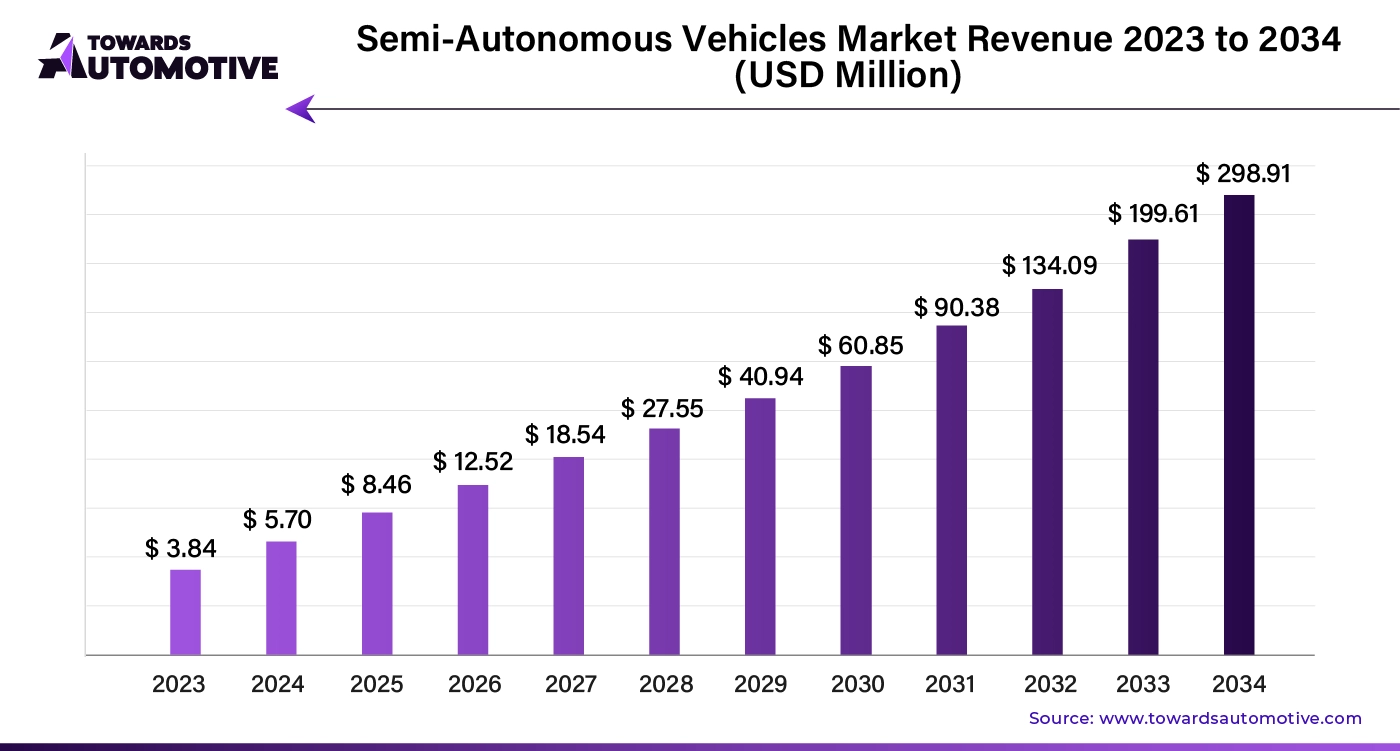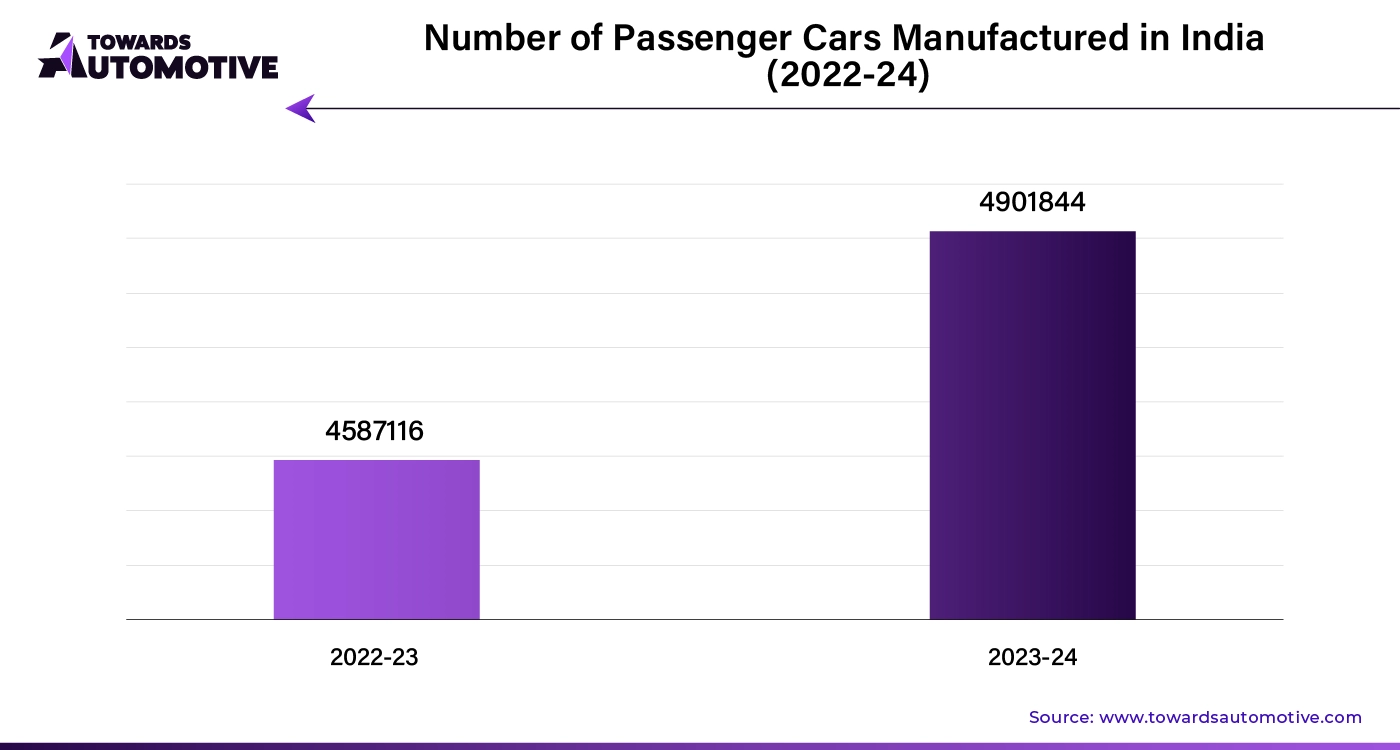April 2025
The global semi-autonomous vehicles market size is calculated at USD 5.70 million in 2024 and is expected to be worth USD 298.91 million by 2034, expanding at a CAGR of 48.55% from 2024 to 2034.

Unlock Infinite Advantages: Subscribe to Annual Membership
The semi-autonomous vehicles market is experiencing significant growth as advancements in automotive technology continue to evolve toward greater automation. Semi-autonomous vehicles, equipped with advanced driver assistance systems (ADAS), are capable of performing certain driving tasks such as lane-keeping, adaptive cruise control, and automated parking, while still requiring human supervision. The market is driven by rising consumer demand for safer, more convenient driving experiences, along with stringent government regulations aimed at reducing road accidents and improving vehicle safety.
Technological innovations, such as sensors, radar, cameras, and artificial intelligence (AI), play a crucial role in enhancing the capabilities of semi-autonomous vehicles. These technologies enable real-time decision-making and allow vehicles to respond to their environment, making driving safer and more efficient. Moreover, the increasing focus on electric and hybrid vehicles, which are often equipped with the latest autonomous driving features, is further propelling the market.
The integration of semi-autonomous technology in commercial vehicles, especially for logistics and delivery services, is another key factor driving growth. Companies are investing in semi-autonomous solutions to improve operational efficiency and reduce human error. With continuous advancements in automation, the semi-autonomous vehicle market is expected to expand rapidly in the coming years.
Artificial intelligence (AI) plays a crucial role in the semi-autonomous vehicles market by enabling vehicles to perform complex driving tasks with enhanced precision and safety. AI technologies, such as machine learning and computer vision, allow semi-autonomous vehicles to process vast amounts of data in real time. This data, gathered from sensors, cameras, radar, and LIDAR systems, helps the vehicle understand its surroundings, predict potential hazards, and make informed decisions.
One key application of AI in semi-autonomous vehicles is in Advanced Driver Assistance Systems (ADAS), which enable features like adaptive cruise control, lane-keeping, automatic braking, and parking assistance. AI algorithms analyze sensor inputs to help the vehicle respond dynamically to road conditions, traffic patterns, and obstacles. This increases safety by reducing the chances of human error, which is a leading cause of accidents.
Moreover, AI facilitates continuous improvement in semi-autonomous systems through machine learning. The more vehicles are driven, the more data they collect, which allows AI models to become more accurate over time. AI also plays a role in driver monitoring systems, which ensure the driver is attentive and ready to take control when necessary.
The growing demand for fuel-efficient vehicles is a key driver of growth in the semi-autonomous vehicles market. As consumers and governments increasingly prioritize sustainability and environmental conservation, the focus on reducing fuel consumption has intensified. Semi-autonomous vehicles, often integrated with advanced driver assistance systems (ADAS) and other automation technologies, are designed to optimize driving patterns and improve fuel efficiency. Features such as adaptive cruise control, automated lane-keeping, and traffic jam assist help vehicles maintain steady speeds, avoid unnecessary acceleration, and reduce idle time, all of which contribute to lower fuel consumption.
Additionally, semi-autonomous systems leverage AI and real-time data to predict traffic patterns and adjust vehicle operations accordingly, further enhancing fuel efficiency. As a result, drivers can achieve more miles per gallon, lowering their overall fuel costs and carbon emissions. This aligns with global trends toward greener, more sustainable transportation solutions.
The shift towards electric and hybrid vehicles, many of which are equipped with semi-autonomous capabilities, also highlights the growing market for fuel-efficient technologies. As consumers seek vehicles that offer both environmental benefits and advanced driving features, the demand for semi-autonomous vehicles continues to rise, positioning this segment for sustained growth.
The semi-autonomous vehicles market faces several restraints, including high development and manufacturing costs, which make these vehicles expensive for consumers. The complexity of integrating advanced technologies such as sensors, AI, and LIDAR drives up production costs. Additionally, regulatory challenges and the lack of standardized safety frameworks slow the widespread adoption of semi-autonomous vehicles. Concerns about cybersecurity and the potential for hacking add to the hesitation, as vehicle automation systems could be vulnerable to attacks. Furthermore, consumer mistrust of self-driving technology and the requirement for human supervision limit the full potential of semi-autonomous vehicle adoption in the market.
Advancements in Advanced Driver Assistance Systems (ADAS) are creating significant growth opportunities in the semi-autonomous vehicles market. ADAS technologies, which include features like adaptive cruise control, lane-keeping assist, automatic emergency braking, and traffic jam assist, are continually evolving to offer more sophisticated automation. These systems enhance vehicle safety, reduce driver fatigue, and improve overall driving efficiency, making semi-autonomous vehicles more attractive to consumers.
As ADAS becomes more refined, it allows vehicles to take on increasingly complex driving tasks with minimal human input. The integration of AI and machine learning enables ADAS to analyze real-time data from sensors, cameras, and radar systems, allowing vehicles to respond dynamically to their environment. This not only enhances safety but also optimizes driving performance, leading to better fuel efficiency and lower emissions.
With regulatory bodies and governments pushing for stricter safety standards, the demand for ADAS-equipped vehicles is expected to rise. Additionally, ADAS plays a crucial role in the development of higher levels of vehicle autonomy, bridging the gap between current semi-autonomous systems and fully autonomous vehicles. As these technologies continue to advance, they are driving the expansion of the semi-autonomous vehicles market by offering enhanced safety, convenience, and efficiency to drivers.
The level 1 segment held the largest share of the market. The Level 1 segment is a key driver of growth in the semi-autonomous vehicles market, as it represents the first stage of vehicle automation widely adopted by consumers. Level 1 semi-autonomous vehicles offer basic driver assistance features, such as adaptive cruise control and lane-keeping assistance, where the vehicle can take over one function while the driver remains in full control of other tasks. This introductory level of automation provides drivers with enhanced convenience and safety, making it an attractive option for those seeking gradual exposure to automated driving technology.
As automakers increasingly incorporate Level 1 systems into their vehicle models, it allows consumers to experience the benefits of automation at a relatively affordable cost. These systems also comply with regulatory standards focused on improving vehicle safety, making them a popular choice among consumers who value enhanced protection on the road. The rising demand for vehicles with basic driver assistance features, especially in regions with stringent safety regulations, further drives the growth of the Level 1 segment.
Moreover, the integration of Level 1 automation in both electric and internal combustion engine vehicles positions it as a key entry point for broader adoption of more advanced semi-autonomous systems, ultimately fueling the growth of the overall semi-autonomous vehicles market.
The passenger car segment led the market. Passenger cars are a major driver of growth in the semi-autonomous vehicles market, as automakers focus on integrating advanced driver assistance systems (ADAS) into mainstream consumer vehicles. The rising demand for safety, convenience, and enhanced driving experience among everyday drivers has led to a surge in the adoption of semi-autonomous features, particularly in passenger cars. Technologies like adaptive cruise control, automated parking, lane-keeping assist, and emergency braking are becoming increasingly common, making driving more efficient and less stressful.
As urbanization and traffic congestion increase globally, more drivers seek out vehicles that can reduce the strain of driving in crowded conditions. Passenger cars equipped with semi-autonomous systems can handle tasks like maintaining a safe distance from other vehicles, navigating traffic jams, and assisting with lane changes, all of which enhance driver comfort and safety.
In addition, governments worldwide are promoting vehicle safety regulations that push automakers to include ADAS features in new passenger cars, further driving demand. As these systems become more affordable and accessible, even mid-range and entry-level passenger cars are expected to incorporate semi-autonomous technologies. The widespread use of these features in passenger cars is a critical factor fueling the growth of the semi-autonomous vehicle market.

North America dominated the semi-autonomous vehicles market. The semi-autonomous vehicles market in North America is experiencing significant growth due to a combination of technological advancements, strong government support, infrastructure development, and investments from automotive companies. Leading automotive and tech firms in the region are pioneering innovations in advanced driver assistance systems (ADAS) and artificial intelligence (AI), driving the development of more sophisticated and reliable semi-autonomous features. These advancements are making semi-autonomous vehicles safer, more efficient, and appealing to consumers, particularly as the technology becomes more affordable and accessible.
Government regulations are also playing a pivotal role in accelerating market growth. In the U.S. and Canada, regulatory bodies such as the National Highway Traffic Safety Administration (NHTSA) have introduced policies encouraging the adoption of semi-autonomous features, like adaptive cruise control and automatic emergency braking, as part of vehicle safety standards. These regulations not only enhance road safety but also foster innovation in the semi-autonomous vehicle sector.
Moreover, investments in smart infrastructure, such as vehicle-to-everything (V2X) communication systems and intelligent transportation networks, are creating an environment that supports the operation of semi-autonomous vehicles. As automotive companies continue to invest in research and development, they are focusing on integrating these vehicles into the existing transportation infrastructure. With strong support from both governments and private enterprises, North America is poised to lead the global shift toward semi-autonomous driving, creating significant growth opportunities in the market.
Asia Pacific is expected to grow with a significant CAGR during the forecast period. The semi-autonomous vehicles market in Asia Pacific is witnessing rapid growth, driven by factors such as rapid urbanization, increasing collaborations and partnerships, and rising demand for safety features. Rapid urbanization across countries like China, India, Japan, and South Korea has led to congested roads and longer commutes, fueling the demand for vehicles equipped with semi-autonomous technologies. Features like adaptive cruise control, lane-keeping assist, and traffic jam assist are becoming essential for drivers seeking convenience and safety in increasingly crowded urban environments.
Collaborations and partnerships between leading automotive manufacturers and technology firms are accelerating the development of semi-autonomous vehicles in the region. Major automakers are investing in research and development and collaborating with tech giants to integrate cutting-edge AI, machine learning, and sensor technologies into their vehicles. These partnerships are fostering innovation, making semi-autonomous vehicles more accessible and affordable for consumers across various market segments.
Additionally, the growing emphasis on vehicle safety, fueled by rising consumer awareness and government regulations, is significantly boosting the adoption of semi-autonomous features. Governments across Asia Pacific are enforcing stricter safety regulations, mandating the inclusion of features like automatic emergency braking and lane departure warning systems. These safety features not only enhance the driving experience but also contribute to a safer road environment. With these combined factors, the semi-autonomous vehicles market in Asia Pacific is poised for robust growth in the coming years, catering to the evolving needs of urban drivers.
| Urbanization % in Asia Pacific Nations (2021-23) | |||
| Country | 2021 | 2022 | 2023 |
| India | 34.6% | 34.9% | 35.3% |
| China | 64.7% | 65.2% | 66.2% |
| South Korea | 57.3% | 57.9% | 58.6% |
By Automation Level
By Vehicle Type
By Components
By Region
April 2025
April 2025
April 2025
April 2025
We offer automotive expertise for market projections and customizable research, adaptable to diverse strategic approaches.
Contact Us